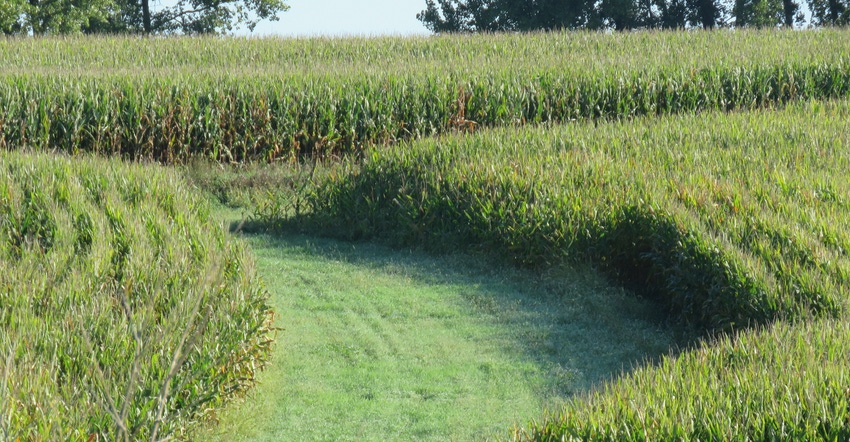
To help reach the water quality improvement goals set by the Iowa Nutrient Reduction Strategy, more farmers need to consider using practices to reduce phosphorus and nitrate loss from fields.
Shawn Richmond, environmental services director at the Agribusiness Association of Iowa, encourages farmers to use the 4R Plus practices that protect and enhance Iowa soils and improve and protect water quality.
The name “4R Plus” refers to the 4R’s of nutrient management — right source, right time, right rate and right place — for applying commercial fertilizer and manure. The “Plus” refers to using the 4R’s along with soil and water conservation practices that also help Iowa reach the NRS goals.
Richmond provided leadership in drafting the NRS, which was released in 2013. It was developed by the Iowa Department of Agriculture, Iowa Department of Natural Resources and Iowa State University. Richmond worked for the Iowa Department of Agriculture and Land Stewardship when the NRS was drafted. In his current role, now working for the Agribusiness Association of Iowa, he focuses on developing and managing environmental programs. He assists fertilizer dealers and other crop input retailers who are members of AAI and, in turn, work with their farmer-customers in putting together nutrient management plans.
Each farm unique
He says it will take a combination of 4R Plus practices to meet the NRS goals of reducing nitrogen and phosphorus loading into Iowa waters — streams, rivers and lakes — from nonpoint sources by 41% and 29%, respectively. The voluntary program has no deadline for the state to meet its water quality improvement goals.
Recognizing that every farm is unique and is going to need a different set of solutions, Richmond encourages farmers to complete an assessment, at least annually, and consider if other 4R Plus practices might help them reach their production and sustainability goals.
“4R Plus is an important program for Iowa and to farmers as they consider the practices that can be used to reduce nutrient and soil loss,” he says. “It’s vital that farms have a whole-system approach — that you consider the in-field and edge-of-field solutions that address nutrient losses.”
Fayette County farmer Tim Recker changed his tillage system after assessing his long-term soil health goals. After a long history of tillage, the northeast Iowa grower set goals to stop erosion, build organic matter and improve soil structure. He switched to a system of no-till that incorporates cover crops.
“I’m seeing better water infiltration, soil not moving, soil health improving and no lack of yields from putting that all together,” Recker says. “Every farmer has a different system, and you have to manage a cover crop just like you manage a corn and soybean rotation. That means planning and following your plan.”
Tailoring practices for farms
There’s not a one-size-fits-all solution to keeping soil and water in place. Farmers have a suite of practices to choose from. When selecting practices, the farm�’s topography is one consideration. “If you farm a rolling or steeply sloping landscape, erosion may be your greatest concern,” Richmond says. “Practices such as terraces, no-till and cover crops help keep soil in place.”
On flatter and tile-drained land, Richmond encourages farmers to consider practices that address nutrient losses. “Managing crop nutrients through use of the 4R’s has economic as well as environmental benefits,” he says. “They save you money by keeping the nutrients in the field where crops can use them. Additionally, practices that help water infiltrate the soil, like cover crops and no-till, also reduce nutrient runoff.”
With a vast array of tools to choose from, farmers are encouraged to work with their agronomist or crop adviser to set reasonable goals and identify potential practices that can be incorporated into the farming operation. Richmond also encourages farmers to visit their local USDA service center to learn about cost-share opportunities. “There are a lot of options for cost-share to help farmers get started with a new practice,” he notes.
Seek information from experts
Well-drained soil is critical to crop productivity, and Richmond recognizes tile drainage systems are commonly updated on farms. “The perfect time to consider installing an edge-of-field practice like a saturated buffer or bioreactor is when drainage tile is being added or modernized,” he says. “These edge-of-field structures significantly reduce nitrates that leave farms, so it can make sense to add them at the same time your tile drainage system work is occurring — either updating or initial installation of tile.”
Richmond wants all farmers to be part of the solution of reducing nutrient loss from fields. “Using the 4R Plus suite of nutrient management practices helps farmers address their productivity and environmental concerns,” he says. “To maintain the freedom of operation we enjoy in Iowa, farmers can look at the menu of options that are scientifically proven to reduce nutrient runoff.”
“What I’ve seen on my farm is the less disruption I can do on my soil, the better,” Recker says. “Getting away from tillage has been mentally challenging because I farm heavy, black soil. We thought we had to turn the soil over to absorb heat to make the corn grow. We’re finding out with today’s advanced seed genetics, we don’t need to do that.”
For more information, visit 4rplus.org.
About the Author(s)
You May Also Like




